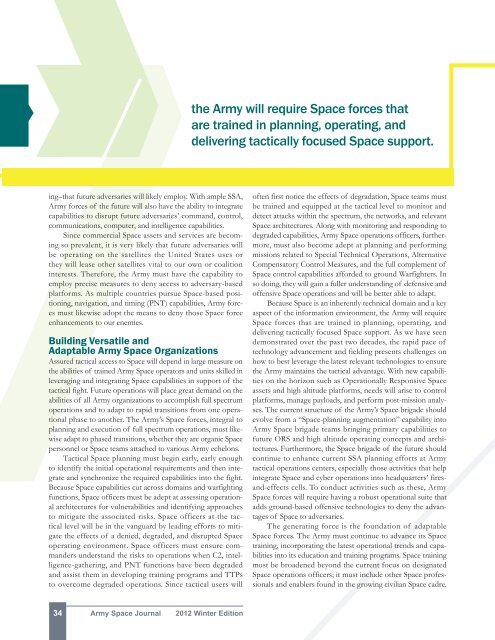2012 Winter - Space and Missile Defense Command - U.S. Army
2012 Winter - Space and Missile Defense Command - U.S. Army
2012 Winter - Space and Missile Defense Command - U.S. Army
You also want an ePaper? Increase the reach of your titles
YUMPU automatically turns print PDFs into web optimized ePapers that Google loves.
the <strong>Army</strong> will require <strong>Space</strong> forces that<br />
are trained in planning, operating, <strong>and</strong><br />
delivering tactically focused <strong>Space</strong> support.<br />
ing–that future adversaries will likely employ. With ample SSA,<br />
<strong>Army</strong> forces of the future will also have the ability to integrate<br />
capabilities to disrupt future adversaries’ comm<strong>and</strong>, control,<br />
communications, computer, <strong>and</strong> intelligence capabilities.<br />
Since commercial <strong>Space</strong> assets <strong>and</strong> services are becoming<br />
so prevalent, it is very likely that future adversaries will<br />
be operating on the satellites the United States uses or<br />
they will lease other satellites vital to our own or coalition<br />
interests. Therefore, the <strong>Army</strong> must have the capability to<br />
employ precise measures to deny access to adversary-based<br />
platforms. As multiple countries pursue <strong>Space</strong>-based positioning,<br />
navigation, <strong>and</strong> timing (PNT) capabilities, <strong>Army</strong> forces<br />
must likewise adopt the means to deny those <strong>Space</strong> force<br />
enhancements to our enemies.<br />
Building Versatile <strong>and</strong><br />
Adaptable <strong>Army</strong> <strong>Space</strong> Organizations<br />
Assured tactical access to <strong>Space</strong> will depend in large measure on<br />
the abilities of trained <strong>Army</strong> <strong>Space</strong> operators <strong>and</strong> units skilled in<br />
leveraging <strong>and</strong> integrating <strong>Space</strong> capabilities in support of the<br />
tactical fight. Future operations will place great dem<strong>and</strong> on the<br />
abilities of all <strong>Army</strong> organizations to accomplish full spectrum<br />
operations <strong>and</strong> to adapt to rapid transitions from one operational<br />
phase to another. The <strong>Army</strong>’s <strong>Space</strong> forces, integral to<br />
planning <strong>and</strong> execution of full spectrum operations, must likewise<br />
adapt to phased transitions, whether they are organic <strong>Space</strong><br />
personnel or <strong>Space</strong> teams attached to various <strong>Army</strong> echelons.<br />
Tactical <strong>Space</strong> planning must begin early, early enough<br />
to identify the initial operational requirements <strong>and</strong> then integrate<br />
<strong>and</strong> synchronize the required capabilities into the fight.<br />
Because <strong>Space</strong> capabilities cut across domains <strong>and</strong> warfighting<br />
functions, <strong>Space</strong> officers must be adept at assessing operational<br />
architectures for vulnerabilities <strong>and</strong> identifying approaches<br />
to mitigate the associated risks. <strong>Space</strong> officers at the tactical<br />
level will be in the vanguard by leading efforts to mitigate<br />
the effects of a denied, degraded, <strong>and</strong> disrupted <strong>Space</strong><br />
operating environment. <strong>Space</strong> officers must ensure comm<strong>and</strong>ers<br />
underst<strong>and</strong> the risks to operations when C2, intelligence-gathering,<br />
<strong>and</strong> PNT functions have been degraded<br />
<strong>and</strong> assist them in developing training programs <strong>and</strong> TTPs<br />
to overcome degraded operations. Since tactical users will<br />
often first notice the effects of degradation, <strong>Space</strong> teams must<br />
be trained <strong>and</strong> equipped at the tactical level to monitor <strong>and</strong><br />
detect attacks within the spectrum, the networks, <strong>and</strong> relevant<br />
<strong>Space</strong> architectures. Along with monitoring <strong>and</strong> responding to<br />
degraded capabilities, <strong>Army</strong> <strong>Space</strong> operations officers, furthermore,<br />
must also become adept at planning <strong>and</strong> performing<br />
missions related to Special Technical Operations, Alternative<br />
Compensatory Control Measures, <strong>and</strong> the full complement of<br />
<strong>Space</strong> control capabilities afforded to ground Warfighters. In<br />
so doing, they will gain a fuller underst<strong>and</strong>ing of defensive <strong>and</strong><br />
offensive <strong>Space</strong> operations <strong>and</strong> will be better able to adapt.<br />
Because <strong>Space</strong> is an inherently technical domain <strong>and</strong> a key<br />
aspect of the information environment, the <strong>Army</strong> will require<br />
<strong>Space</strong> forces that are trained in planning, operating, <strong>and</strong><br />
delivering tactically focused <strong>Space</strong> support. As we have seen<br />
demonstrated over the past two decades, the rapid pace of<br />
technology advancement <strong>and</strong> fielding presents challenges on<br />
how to best leverage the latest relevant technologies to ensure<br />
the <strong>Army</strong> maintains the tactical advantage. With new capabilities<br />
on the horizon such as Operationally Responsive <strong>Space</strong><br />
assets <strong>and</strong> high altitude platforms, needs will arise to control<br />
platforms, manage payloads, <strong>and</strong> perform post-mission analyses.<br />
The current structure of the <strong>Army</strong>’s <strong>Space</strong> brigade should<br />
evolve from a “<strong>Space</strong>-planning augmentation” capability into<br />
<strong>Army</strong> <strong>Space</strong> brigade teams bringing primary capabilities to<br />
future ORS <strong>and</strong> high altitude operating concepts <strong>and</strong> architectures.<br />
Furthermore, the <strong>Space</strong> brigade of the future should<br />
continue to enhance current SSA planning efforts at <strong>Army</strong><br />
tactical operations centers, especially those activities that help<br />
integrate <strong>Space</strong> <strong>and</strong> cyber operations into headquarters’ fires<strong>and</strong>-effects<br />
cells. To conduct activities such as these, <strong>Army</strong><br />
<strong>Space</strong> forces will require having a robust operational suite that<br />
adds ground-based offensive technologies to deny the advantages<br />
of <strong>Space</strong> to adversaries.<br />
The generating force is the foundation of adaptable<br />
<strong>Space</strong> forces. The <strong>Army</strong> must continue to advance its <strong>Space</strong><br />
training, incorporating the latest operational trends <strong>and</strong> capabilities<br />
into its education <strong>and</strong> training programs. <strong>Space</strong> training<br />
must be broadened beyond the current focus on designated<br />
<strong>Space</strong> operations officers; it must include other <strong>Space</strong> professionals<br />
<strong>and</strong> enablers found in the growing civilian <strong>Space</strong> cadre.<br />
34 <strong>Army</strong> <strong>Space</strong> Journal <strong>2012</strong> <strong>Winter</strong> Edition
















